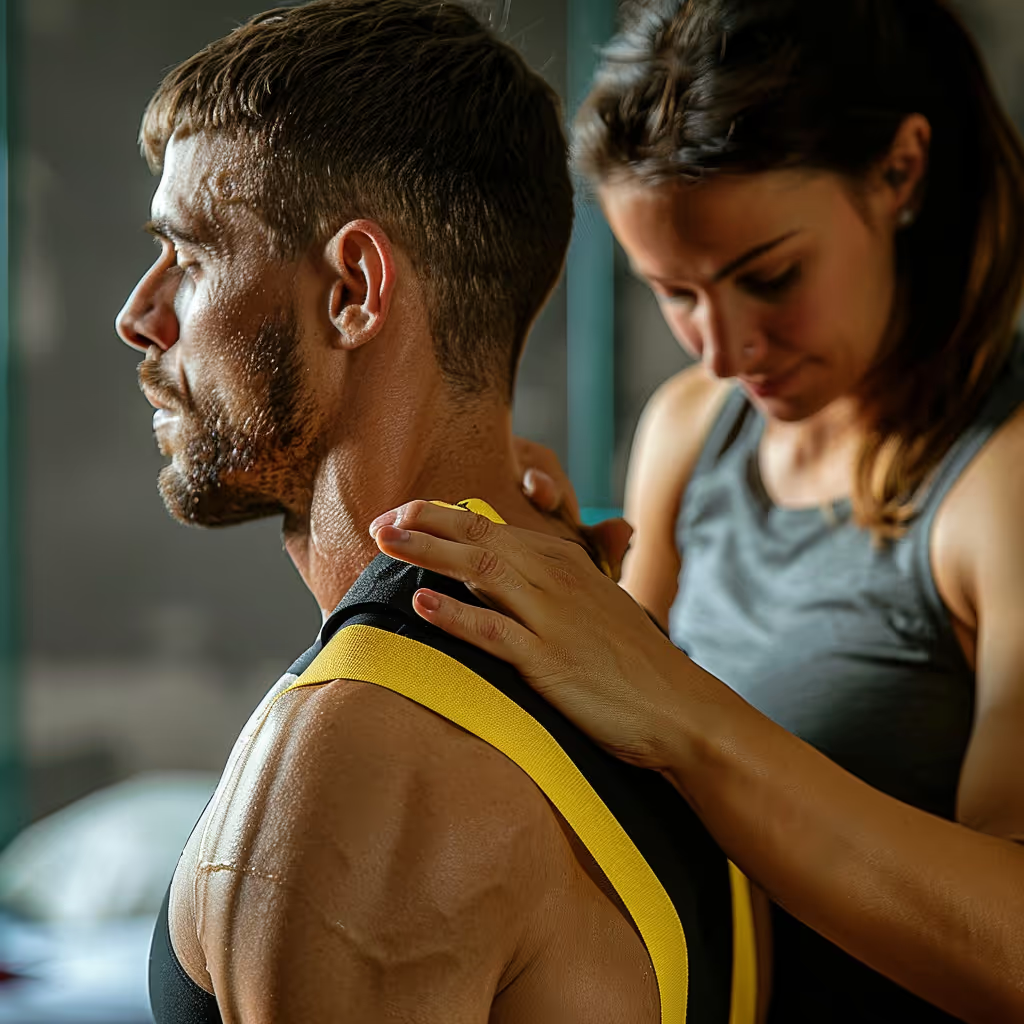Osteoporosis/Osteopenia
Osteoporosis is a progressive decrease in bone density, which makes the bones more fragile. In the lumbar region, osteoporosis is the gradual deterioration of the vertebrae in the lower back.
What is lumbar osteoporosis?
Osteoporosis is a progressive decrease in bone density, which makes the bones more fragile. In the lumbar region, osteoporosis is the gradual deterioration of the vertebrae in the lower back.
What are the symptoms of lumbar osteoporosis?
It's important to understand that osteoporosis doesn't always cause symptoms. Many people live with osteoporosis and feel absolutely nothing.
When osteoporosis is symptomatic, here's what people may experience:
- Pain and/or stiffness in the lower back that appears gradually
- Back stiffness that is worse upon waking up in the morning
- Decreased trunk mobility
In general, there can be two types of symptoms:
- Osteoporosis with symptoms in lumbar flexion (rounded back)
- Osteoporosis with symptoms in lumbar extension (hollow back)
Here are the positions or movements that increase pain depending on the type of symptoms:
For osteoporosis with symptoms in lumbar flexion (rounded back), pain is increased by one or more of the following:
- Sitting for long periods
- Driving for a long time
- Bending over
- Putting on socks, pants, underwear, shoes
- Sneezing or coughing
For osteoporosis with symptoms in lumbar extension (hollow back), pain is increased by one or more of the following:
- Walking for a long time (worse if walking slowly, better if walking faster)
- Standing for a long time (grocery shopping, cooking, waiting in line, or watching a show while standing still)
- Lying on your stomach or on your back with your legs extended
- Reaching for objects overhead, such as in kitchen cabinets.
It's possible to have both types of symptoms at the same time, and therefore have symptoms that fall into both categories. However, one category is often worse.
What are the serious symptoms of lumbar osteoporosis to watch out for?
The presence of certain signs and symptoms should prompt you to seek immediate medical attention at the emergency room or from a doctor. These include:
- Severe weakness or paralysis of one or both legs
- Significant or even complete loss of sensation in one or both legs
- Recent loss of balance when walking
- Significant and new incoordination
- New difficulties with bladder or bowel control
- Loss of sensation in the genital area or when wiping after a bowel movement
Serious symptoms are only present in less than 1% of lower back pain cases. Most of the time, although the pain can be very unpleasant, the condition improves.
What are the causes of osteoporosis?
Here are the risk factors that lead more quickly to osteoporosis:
- More common in people over 50 years of age
- Menopausal women are most at risk of suffering from it
- Being sedentary
- Poor metabolic health (diabetes, high blood pressure, significant excess weight, poor cholesterol)
- Certain nutritional deficiencies
How is osteoporosis diagnosed?
Diagnosis can be made based on a review of your symptoms and a clinical examination. Sometimes, a bone mineral density test (assessing the quality of the bone structure) may be necessary.
It's important to know that medical imaging (X-rays, MRIs, etc.) isn't relevant in 99% of back pain cases.
When should you consult a physiotherapist for lumbar osteoporosis?
You should consult a physiotherapist if you have one or more of the symptoms described above or if your doctor has ruled out any other causes that could explain your pain.
You do not need to see a doctor before consulting a physiotherapist. If your condition requires you to see a doctor, your physiotherapist will be able to tell you.
What are the physiotherapy treatments for lumbar osteoporosis?
Your physiotherapist will perform an assessment to determine why your osteoporosis is causing you pain. To do this, they will evaluate the following elements:
- The mobility of your spine
- The gliding of your nerves
- Your postural habits
- The quality of your movements
- Your strength and stability
- Based on the assessment results, the physiotherapist will: Mobilize the joints in your back and your nerves to reduce pain and improve movement.
- Will give you specific exercises to do at home to address the cause of the problem and reduce pain.
- Teach you how to properly manage your daily activities and hobbies to optimize healing
- Will give you advice for your postural habits and movements.
"It is important to note that osteoporosis itself cannot be cured, as it is a degenerative process that is irreversible. However, the symptoms associated with lumbar osteoporosis can be completely eliminated with treatment, even if osteoporosis is still present in the bones."
What can you do at home for lumbar osteoporosis?
Temporarily stop doing the movements that cause too much pain, and then gradually start doing them again. Don't remain completely still for long periods, as you will become stiffer and experience more pain afterward.
"The best thing to do is to be active. If you are sedentary, start by taking regular walks and doing mobility exercises for your back every day, while respecting your pain levels. If you are already active, continue your activities that do not cause too much pain."
Here are some tips that may help depending on the type of symptoms you have:
For symptoms in lumbar flexion (rounded back):
- Limit the time spent sitting (get up every 20 minutes to walk a little).
- When you are sitting, straighten your lower back a little by sticking your buttocks out. Place a rolled-up towel in your lower back to remind you to sit up straighter.
- Go for frequent walks for a duration that is comfortable. Running might even be good for you (it depends on the person).
- In the car, sit well back in the seat and tilt the backrest slightly backward. Move the seat slightly closer to the steering wheel.
- Stick your buttocks out slightly to lean forward.
- When the pain is present, spend a few minutes on your stomach or on your back with your legs extended. This should relieve you.
For symptoms in lumbar extension (arched back):
- Limit the time spent standing (sit down every 20 minutes while the pain decreases).
- If you are standing still, place one foot in front of the other and make small weight transfers forward and backward.
- When cooking, place one foot inside the cabinet in front of you.
- When the pain is present, spend a few minutes lying on your side with a pillow between your knees. This should relieve you.
If you don't see any improvement after 10 days, you should consult a physiotherapist.
Did you know?
- 90% of lower back pain episodes heal in 6 to 12 weeks
- 50% of lower back pain episodes heal in 1-2 weeks
- Regular physical activity and a balanced diet throughout your life are the best ways to delay and limit the onset of osteoporosis.
To learn more...
You can listen to the podcast "Parle-moi de santé" produced by one of our physiotherapists, Alexis Gougeon. Episode #7 discusses the topic of lower back pain.
Episode #7 Low Back Pain
Find the episode on YouTube :
Click below to listen to episodes on podcast platforms:

https://open.spotify.com/episode/3Ymcb0gWLyns48Kb6vJ5J8?si=092c6516549b47d7
(4).png)
Sources
- Alexander CE, Varacallo M. Lumbosacral Radiculopathy. InStatPearls [Internet] 2019 Mar 23. StatPearls Publishing.
- Lindsey T, Dydyk AM. Spinal osteoarthritis. InStatPearls [Internet] 2020 Jan 7. StatPearls Publishing.
- Goode AP, Carey TS, Jordan JM. Low back pain and lumbar spine osteoarthritis: how are they related?. Current rheumatology reports. 2013 Feb 1;15(2):305.
- Pouresmaeili F, Kamalidehghan B, Kamarehei M, Goh YM. A comprehensive overview on osteoporosis and its risk factors. Therapeutics and clinical risk management. 2018;14:2029.
Videos in this category
Other conditions
Hip osteoarthritis is a normal wear and tear of the hip joint. Osteoarthritis is often described as the wearing away of cartilage between our bones. While this is true, it involves more than just cartilage. Cartilage is a tissue that acts like a cushion between the surfaces of our bones, allowing our joints to glide smoothly and move with ease.
It is a normal wear and tear of the knee joint. Osteoarthritis is often described as the wearing away of cartilage between our bones. While this is true, it involves more than just cartilage. Cartilage is a tissue that acts like a cushion between the surfaces of our bones, allowing our joints to glide smoothly and move with ease.
It is a normal wear and tear of the joints in the lower back vertebrae. Osteoarthritis is often described as the wearing away of cartilage between our vertebrae. While this is true, it involves more than just cartilage. Cartilage is a tissue that acts like a cushion between the surfaces of our vertebrae, allowing them to glide smoothly and move with ease.
A bursa is like a small, very thin, fluid-filled sac found in several joints throughout the body. This small sac acts as a cushion in the joint and lubricates structures that are exposed to more friction.
It is an inflammation of the subacromial bursa in the shoulder joint.
It is a tissue that surrounds the shoulder and allows the shoulder bone to stay in place within the joint. The capsule helps to stabilize the joint.
Cervicalgia is a general term to describe neck pain that does not have a specific cause, such as an accident or sudden movement. Cervicalgia is therefore synonymous with ''I have a pain in my neck and nothing in particular happened''.
In both injuries, there is pain felt in the neck that then radiates into the arm, or vice versa.
It is a significant stretch or tear of the muscle fibers in the groin or inner thigh muscles.
It is a significant stretch or tear of the muscle fibers in the hamstring muscles located at the back of the thigh.
This is a significant stretch or tear of the muscle fibers in the calf muscles (soleus and gastrocnemius).
This is a significant stretch or tear of the muscle fibers in the quadriceps, which is the large muscle at the front of the thigh.
Book an appointment now
We offer a triple quality guarantee: optimized time, double physiotherapy assessment, and ongoing expertise for effective care tailored to your needs.


Our clients' satisfaction is our priority.
At Physioactif, excellence defines our approach. But don't take our word for it, see what our patients are saying.
Discover our physiotherapy clinics
We have multiple locations to better serve you.
Blainville
190 Chem. du Bas-de-Sainte-Thérèse Bureau 110,
Blainville, Quebec
J7B 1A7
Laval
Montreal
St-Eustache
Vaudreuil
21 Cité-des-Jeunes Blvd. Suite 240,
Vaudreuil-Dorion, Quebec
J7V 0N3
Book an appointment now

